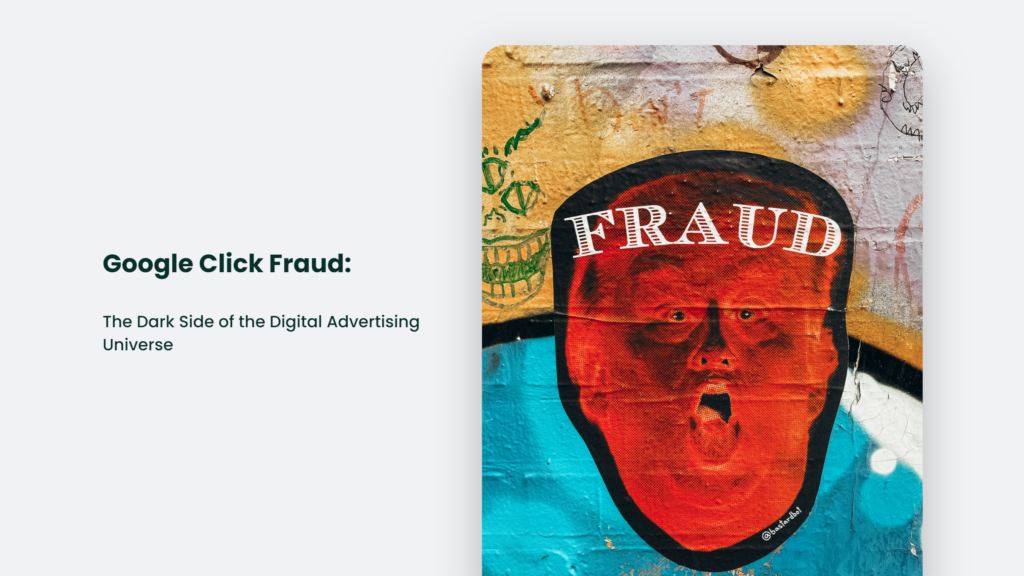Imagine you’re a marketing superhero whose task is to save innocent advertisers from the evil clutches of Google click fraud. Armed with knowledge, insights, and witty jokes, you swoop in, ready to rid the digital world of this nefarious practice. But first, let’s set the stage with a little storytelling.
Once upon a time, in the enchanted land of digital advertising, there was a magical castle called Google. The benevolent sorcerers at Google created a potent potion called AdWords that promised to bring abundant riches to all who used it.
But little did they know, lurking in the shadows were cunning villains, plotting to exploit the very system designed to help others.

The Enigmatic Enemy: Google Click Fraud
“Click fraud, eh? What’s that?” you might ask, with a quizzical brow and a dash of scepticism. Well, my dear reader, click fraud is the dark art of generating fake clicks on pay-per-click (PPC) ads, with the sinister goal of draining advertisers’ budgets and filling the pockets of the fraudsters.
Picture this:
A greedy goblin sets up a website with the sole purpose of displaying ads. It then unleashes an army of bots or perhaps even enlists the help of unsuspecting humans to click on the ads, creating an illusion of genuine interest. Every click generates revenue for the goblin, while the poor advertiser is left scratching their head, wondering why their ads aren’t converting.
But fear not, for I, Konger, the digital marketing wizard, am here to guide you through the treacherous terrain of click fraud and show you how to protect your precious ad budget.
A Poll: Test Your Google Click Fraud Savvy
Let’s start with a quick poll to get your brain juices flowing. What do you think is the most common form of click fraud?
- Bots
- Click farms
- Competitors clicking on your ads
- Accidental clicks
Take a moment to ponder, and then read on to see if your click fraud instincts are on point.
The Many Faces of Google Click Fraud: Examples from the Dark Side
There’s more than one way to skin a cat (not that I’m advocating for cat skinning, of course), and there’s more than one way to commit click fraud. Here’s a rundown of the most common types:
- Bots: These soulless machines are programmed to click on ads, inflating click-through rates (CTRs) and burning through your budget faster than you can say “artificial intelligence.”
- Click farms: Picture a dingy warehouse filled with rows upon rows of phones and tablets, manned by an army of workers whose sole job is to click on ads all day. This Dickensian scene is a click farm and is as depressing as it sounds.
- Competitors clicking on your ads: A dastardly deed indeed! Some unscrupulous businesses will click on their competitors’ ads, hoping to deplete their ad budget and gain a competitive advantage.
- Accidental clicks: Sometimes, click fraud isn’t malicious but merely a case of fat fingers or clumsy thumbs. People may accidentally click on your ads while browsing, causing unintentional click fraud.
You were right if you chose any of the options in the poll! These are all common forms of click fraud, and each pose a unique challenge to advertisers.
The Battle Plan: Strategies to Combat Google Click Fraud
Now that we’ve identified the enemy, it’s time to arm ourselves with the tools and tactics to fight back. Here are some tried-and-true strategies to help you thwart click fraud:
- Monitor your campaigns closely: Keep a hawk-like eye on your ad performance, looking for sudden click spikes or suspicious patterns. If something seems fishy, investigate further.
- Set up IP exclusions: If you identify a specific IP address generating fraudulent clicks, you can block it from seeing your ads by setting up IP exclusions in your Google Ads account.
- Adjust your targeting: By narrowing down your target audience, you can reduce the likelihood of click fraud. For example, try excluding certain geographic locations, devices, or timeframes where click fraud is more prevalent.
- Use smart bidding strategies: Google’s machine learning algorithms can help you optimize your bidding strategy, making it more difficult for fraudsters to game the system.
- Employ third-party click fraud protection tools: Several companies specialize in click fraud detection and prevention, such as ClickCease and PPC Protect. These tools can be a valuable ally in your battle against click fraud.
Frequently Asked Questions:
How can I tell if I’m a victim of click fraud?
Keep an eye on your ad performance metrics, particularly CTRs, conversion rates, and bounce rates. Unusual fluctuations or patterns may indicate click fraud.
Can I get a refund for fraudulent clicks?
Google offers an Invalid Clicks Refund program. If you suspect click fraud, report it to Google, and they’ll investigate. If your claim is validated, you may receive a refund.
How can I prevent click fraud on other advertising platforms like Facebook or Bing?
While each platform has its own unique features, the strategies for combating click fraud remain similar. Monitor your ad performance closely, adjust your targeting, employ smart bidding strategies, and consider using third-party click fraud protection tools.
The Final Word: A Call to Action Against Click Fraud
In the words of the great digital marketing philosopher (and Spider-Man’s uncle), Ben Parker, “With great power comes great responsibility.” As advertisers, it’s our duty to arm ourselves with knowledge and stand up against the sinister forces of click fraud.
So, strap on your marketing superhero cape and join me in the battle against Google click fraud. Together, we can make the digital advertising world a safer, more prosperous place for all.
And with that, I bid you adieu, dear reader. May your clicks be genuine, your conversions plentiful, and your ad budget evergreen.




